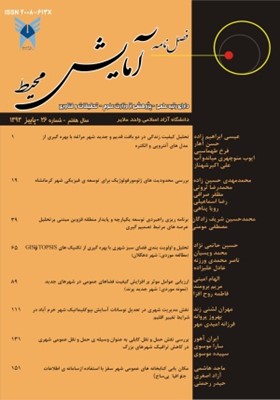بررسی نقش حمل و نقل کابلی به عنوان وسیله حمل و نقل عمومی شهری در کاهش ترافیک شهرهای بزرگ
محورهای موضوعی : آمایش محیطایران آهور 1 * , سارا موسوی 2 , سپیده موسوی 3
1 - (دکتری جغرافیا و برنامه ریزی شهری، دانشگاه آزاد اسلامی، واحد علوم و تحقیقات، تهران)
2 - (کارشناسی ارشد جغرافیا و برنامه ریزی شهری، دانشجوی دکتری جغرافیا و برنامه ریزی شهری، دانشگاه آزاد اسلامی، واحد علوم و تحقیقات، تهران)
3 - (کارشناسی ارشد معماری، دانشگاه آزاد اسلامی واحد تبریز، مدرس دانشگاه آزاد اسلامی واحد تبریز)
کلید واژه: حمل و نقل شهری, سیستم حمل و نقل کابلی, گوندولا, وسایل حمل و نقل عمومی,
چکیده مقاله :
دسترسی به حمل و نقل ایمن، راحت و کم هزینه حق طبیعی هر شهروند محسوب می شود و همین مساله کیفیت زندگی در مناطق شهری را مشخص می کند. برای بخش صنایع و خدمات نیز حمل و نقل پشتوانه مهمی است. سیستم حمل و نقل در دنیای امروز، روز به روز بیش تر رشد می کند. گوندولاها یا سیستم های حمل و نقل کابلی سیستم های حمل و نقل جدیدی هستند که یک کابین بدون موتور توسط یک کابل فولادی کالاها و مسافرین را جابجا می کند. مقاله حاضر سعی دارد برای کنترل بخشی از ترافیک شهری، سیستم حمل و نقل کابلی را به عنوان مکمل و در کنار سایر سیستم های حمل و نقل شهری به عنوان تسهیل کننده رفت و آمد پیشنهاد کند. بدین منظور و چون در کشور ایران نمونه موردی حمل ونقل کابلی به عنوان سیستم حمل و نقل عمومی در شهر وجود ندارد و فقط از سیستم های کابلی به عنوان یک وسیله تفریحی عموماً در مناطق گردشگری استفاده شده است در این مقاله به دو تجربه موفق پیاده شده در دو کشور کلمبیا و ونزوئلا پرداخته شده و مزایای استفاده از این سیستم مورد تحلیل و بررسی قرار گرفته تا در صورت پایین بودن هزینه های اجرایی این طرح و سنجش میزان عملی بودن آن درکلان شهرها از جمله شهر تبریز، شهر اولین ها، در قسمتی از مناطق شلوغ و پرتردد شهر به عنوان گره گشا در ترافیک پیچیده شهر استفاده گردد.
Access to safe, convenient, low-cost transport is a natural right of every citizen and this determines the quality of life in urban areas. Cable Propelled Transit (CPT) is a transportation technology that moves people in motor-less, engine-less vehicles that are propelled by a steel cable. The two main CPT configurations include Top-Supported systems (vehicles/cabins supported from above) and Bottom-Supported systems (cabins supported from below via tracks).Monocable Detachable Gondola (MDG) is the most basic and common CPT systems used for urban transit installations. This technology utilizes a single cable which provides both propulsion and support. Since the cable line circulates continuously around two end terminals, MDGs are classed as continuously circulating systems. An MDG’s detachable grip enables cabins to detach from the propulsion cable upon entering a station and reattaching when exiting. MDG cabins typically seat 8 passengers but can have capacities ranging anywhere from 4-15 riders. They are increasingly popular forms of public transportation due to their high reliability, modest capacities and relative low cost and quick implementation times. Technical Stats Application: MDG systems are well-suited and easily adapted to the urban environment whether it’s built on challenging topography or flat land. In large cities, they typically complement rapid transit trunk lines by functioning as feeder systems. However, in smaller cities with lower transport demands, they can operate as a primary transportation line.MDG systems are also the most common tourist-oriented gondola systems found in cities. This paper tries to offer cable transit system to control a part of urban traffic congestion and facilitate movement of people along with other urban transit systems to facilitate commuting. Therefore, as in our country there is not an applied example of cable transit system as a public urban system and we only use this system as a tourism system and as a twin winter mostly applied, we implemented two successful experiences in Colombia and Venezuela, to analyses the advantage of this system. After analyses Measurement and Assess of the Practicality of the project in city if it was possible, we would propose it to city council.

